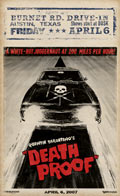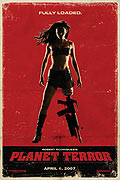 I like to keep these environs hype-free as a general rule, but I really like the posters that have come over the transom for “Planet Terror” and “Death Proof,” the segments directed by Robert Rodriguez and Quentin Tarantino, respectively, for the April release of Grindhouse. (Click each image for a larger version.)
I like to keep these environs hype-free as a general rule, but I really like the posters that have come over the transom for “Planet Terror” and “Death Proof,” the segments directed by Robert Rodriguez and Quentin Tarantino, respectively, for the April release of Grindhouse. (Click each image for a larger version.)
 I’m not a Rodriguez fan — didn’t even care much for Sin City outside of the segments that leaned heavily on Mickey Rourke’s terrific performance — but he and Tarantino continue to make technical strides that relate very specifically to the quality of the image. According to IMDb, they’re shooting with the new Panavision Genesis digital camera that was used for Click, Superman Returns, and Apocalypto. That explains the creaminess of the skin tones and the flatness of the shadows in the new teaser. (Watch it in high-definition if you can – it’s kind of amazing.) Then again, IMDb obviously has the intended aspect ratio wrong, so who knows?
I’m not a Rodriguez fan — didn’t even care much for Sin City outside of the segments that leaned heavily on Mickey Rourke’s terrific performance — but he and Tarantino continue to make technical strides that relate very specifically to the quality of the image. According to IMDb, they’re shooting with the new Panavision Genesis digital camera that was used for Click, Superman Returns, and Apocalypto. That explains the creaminess of the skin tones and the flatness of the shadows in the new teaser. (Watch it in high-definition if you can – it’s kind of amazing.) Then again, IMDb obviously has the intended aspect ratio wrong, so who knows?
 If you’re keeping score, Rodriguez — who is also the cinematographer on Grindhouse — had previously used Sony digital cameras for movies including Sin City, while Tarantino has, until this project, shot only on film, albeit employing a digital intermediate (meaning the filmed images are “scanned” for manipulation as digital images before being output back to film) on the Kill Bill movies.
If you’re keeping score, Rodriguez — who is also the cinematographer on Grindhouse — had previously used Sony digital cameras for movies including Sin City, while Tarantino has, until this project, shot only on film, albeit employing a digital intermediate (meaning the filmed images are “scanned” for manipulation as digital images before being output back to film) on the Kill Bill movies.
What really sells the footage as a throwback to 70s exploitation-style filmmaking, though, is the layer of grain and film distress they’ve add to the digital image. Even the blown-out highlights — an unfortunate hallmark of digital cinematography — make sense in this context, since you sometimes get similar artifacts when a film goes through multiple or substandard optical duplication processes.
Judging from the trailer, which is 2.35:1, it also looks like Tarantino knows exactly what he’s doing with the widescreen frame. (Rodriguez not quite so much.) Anyway, can’t wait.

Tarantino is really underestimated as a ‘scope director. (Not that that sort of thing is mainstream conversation, anyway.) Ironically, he says his aesthetic is largely informed by having been weaned on pan-and-scan versions of widescreen films.
See, that resonates with me. I think there’s a very specific and interesting shared aesthetic among the generation of movie buffs who came up watching old movies in pan-and-scan on television.
It took me a while to figure out that the movie theater screen had a different shape from the TV screen. I had bootleg copies of The Empire Strikes Back and Return of the Jedi at one point, and they were both widescreen. (Well, the camcorder had been pointed at the screen in such a way that you saw more of the picture than you would in a pan-and-scan transfer.) So I was starting to realize something was up. And once I reached college, when I started to understand film formats and got hold of a laserdisc player so I could watch them in widescreen, it was like a revelation. Finally, and in retrospect, the atrocious visual sensibility of so many movies I had watched on HBO and Cinemax was redeemed — it wasn’t those movies at all. It was the way they had been destroyed for cable broadcast!
In a way, I think knowing what pan-and-scan versions look like makes you all the more sensitive to the possibilities of the widescreen frame. Of course, widescreen hasn’t really been the same since “Super 35” came into the picture, and I haven’t decided yet what I think of widescreen movies being shot with digital cameras. I guess it depends on the lens as much as anything — are you shooting widescreen with an anamorphic lens, or are you shooting widescreen by throwing away the top and bottom of your digital image, a la Attack of the Clones?
The funny thing about the rise of digital cinema is it make you aware of how important optics are — lenses, light-sensitivity and the size/shape of the optical sensor inside the camera — compared to pure image resolution when you think about the qualities of an image.